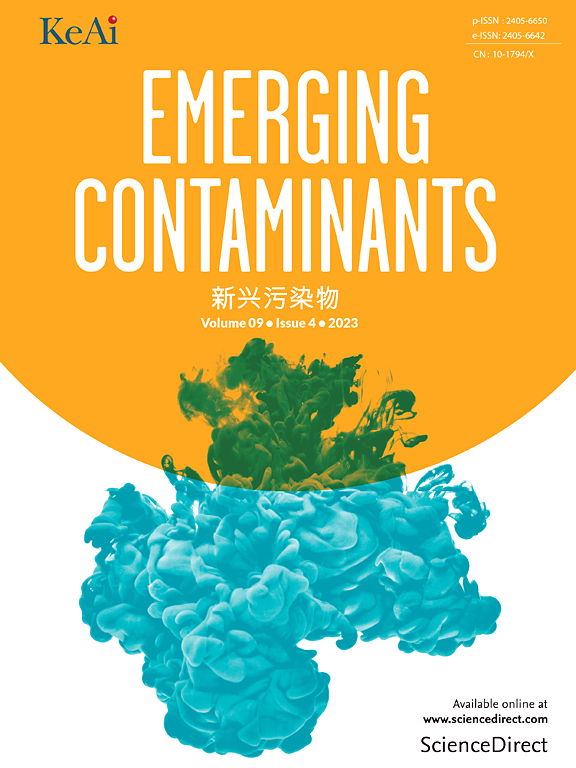城市固体废物处理和处置综合体中空气传播的微塑料污染:浓度、表征和组成
IF 6.9
2区 环境科学与生态学
Q1 ENVIRONMENTAL SCIENCES
引用次数: 0
摘要
城市生活垃圾的处理和处置设施对污染物的排放起着重要作用。我们设计了这项研究,以调查从伊朗最大的城市固体废物处理和处置综合体(MSWPDC)的不同地点(预处理大厅、办公楼、窗口堆肥区、堆肥精炼厂、垃圾填埋场、焚烧厂和背景)收集的空气样本中的一种新兴环境污染物——空气中微塑料(MPs)。我们采用了定性和定量的方法,利用立体显微镜和微拉曼光谱分析了空气中MPs的特征。空气中MPs浓度范围为1.7 ~ 24.7 N/m3,平均±标准差为6.54±5.08 N/m3。以窗内堆肥区浓度最高,平均浓度为12.4±9.32 N/m3。在给定形态下,纤维所占比例最高,约占总数的64%。所有机载MPs的尺寸范围在5 ~ 2984 μm之间,主要在100 ~ 500 μm之间。在成分和颜色方面,PET/聚酯和透明占主导地位,分别占26%和32%。我们的研究结果表明,在Aradkooh MSWPDC的空气中存在高浓度的MPs。研究结果强调了实施更强有力的措施来减少MPs排放的重要性,因为AMSWPDC可能是周边地区MPs污染的潜在来源。本文章由计算机程序翻译,如有差异,请以英文原文为准。

Airborne microplastics pollution in municipal solid waste processing and disposal complex: Concentration, characterization, and composition
Processing and disposal facilities of municipal solid waste play a significant role in emitting pollutants. We designed this study to investigate one of the emerging environmental pollutants, airborne microplastics (MPs), in the air samples collected from various locations (pre-processing hall, office building, windrow composting area, compost refinery plant, landfill sites, incineration plant, and background) of the largest municipal solid waste processing and disposal complex (MSWPDC) in Iran. We employed a qualitative and quantitative approach using a stereo microscope and micro Raman spectroscopy to analyze the airborne MPs feature. Airborne MPs concentration ranged from 1.7 to 24.7 N/m3 with an average (± standard deviation (of 6.54 ± 5.08 N/m3. The highest concentrations were found in the windrow composting area, with an average concentration of 12.4 ± 9.32 N/m3. Given morphologies, fibers exhibited the highest proportion, making up approximately 64 % of the total. All airborne MPs had a size range between 5 and 2984 μm, mainly in the range of 100–500 μm. Regarding composition and color, PET/Polyester and transparent were the dominant, accounting for 26 % and 32 % of the total, respectively. Our findings showed a high concentration of MPs in the air of the Aradkooh MSWPDC. The findings underscore the importance of implementing stronger measures to reduce MPs emissions, as AMSWPDC could be a potential source of MPs pollution in the surrounding areas.
求助全文
通过发布文献求助,成功后即可免费获取论文全文。
去求助
来源期刊

Emerging Contaminants
Medicine-Public Health, Environmental and Occupational Health
CiteScore
10.00
自引率
6.70%
发文量
35
审稿时长
44 days
期刊介绍:
Emerging Contaminants is an outlet for world-leading research addressing problems associated with environmental contamination caused by emerging contaminants and their solutions. Emerging contaminants are defined as chemicals that are not currently (or have been only recently) regulated and about which there exist concerns regarding their impact on human or ecological health. Examples of emerging contaminants include disinfection by-products, pharmaceutical and personal care products, persistent organic chemicals, and mercury etc. as well as their degradation products. We encourage papers addressing science that facilitates greater understanding of the nature, extent, and impacts of the presence of emerging contaminants in the environment; technology that exploits original principles to reduce and control their environmental presence; as well as the development, implementation and efficacy of national and international policies to protect human health and the environment from emerging contaminants.
 求助内容:
求助内容: 应助结果提醒方式:
应助结果提醒方式:


